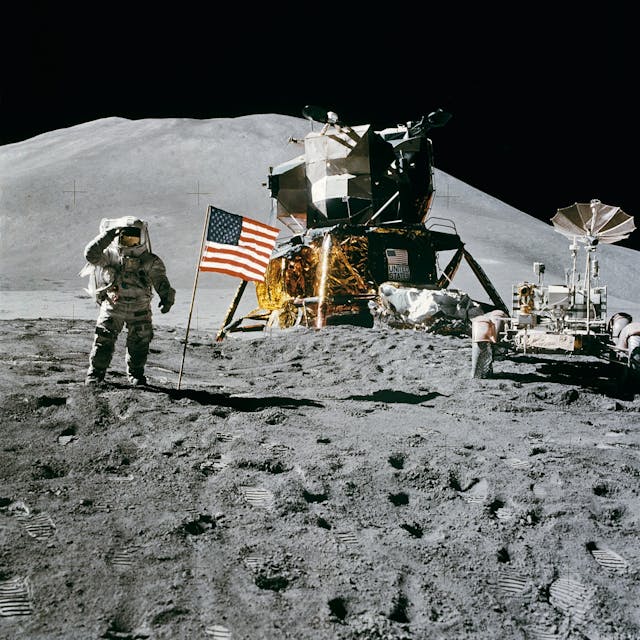
Why is the moon covered in dust? The fine layer of dust that the moon is covered with is called lunar regolith and it has been made by meteoroids and the solar wind.
If you look at videos of the moon landings, the astronauts jump around, and every time they impact the surface of the moon, they kick up clouds of dust. Then there are the famous photos of the astronauts’ boots in the dust and the tracks of the rovers. Then, when the Lunar Module takes off to leave the moon’s surface, it blasts up clouds of dust again. Where did all that moon dust come from?
When we get sand, soil, and loose dirt on Earth, it is usually made by the weathering of some other object. Sand is made from rocks that are slowly ground down, and soil is made from pieces of weathered rocks mixed with organic matter and other things. Rocks are incredibly hard, but nothing is strong enough to survive eons of weathering. They are broken down by wind, water, impacts, freeze and melt cycles, and plants and animals. Wind can’t break down rocks on its own, but the sand and the particles it carries can. Strong wind can be like sandblasting on the surface, and over time, wind can break down rocks. Water, in the form of rain, rivers, or the sea, can weather rocks. This usually happens because of the particles they carry and is similar to the wind, but it can also be chemical. Acid rain is regular rain with a lot of carbon dioxide in it, and this can dissolve rock. Water can also get into cracks in the rocks, and when it freezes, it expands and cracks the rocks. And plants and animals can burrow or grow into cracks and enlarge them, breaking up rocks. These are some of the ways rocks become dust on Earth. The moon doesn’t have any wind, water, or plants and animals, so how did its rocks become dust?
The moon doesn’t have the forces that cause weathering on Earth, but it has a couple that we don’t have. The first is meteorite impacts. Earth is hit by roughly 17,000 meteorites every year. The vast majority of those are so small that they burn up in the atmosphere, or if they happen to be large enough to get through, most of the rest land in the sea. They have almost no impact on Earth. Once every 100 years, there might be a meteorite large enough to make a crater, but they are few and far between. The moon gets hit by a lot of meteorites every year, but the main difference between the moon and the Earth is that the moon gets hit by a lot of small meteorites as well. The moon has no atmosphere to deflect anything, and roughly 100 ping pong sized meteorites hit the surface of the moon every day. They come in very fast, sometimes over 200,000 km/h, and each one hits the surface of the moon with the force of 3.2 kg of dynamite, which is more than enough to break some rocks into powder. And the larger the meteorites get, the more force they have when they impact. The moon has been around for 4.5 billion years and has never had any protection from these meteorites. That is the main reason why its surface is covered in dust. Many of the rocks have been pulverized. Even particle sized meteorites would do significant damage.
The moon is also constantly bombarded by the solar wind. Our magnetic field saves us from its effects, but the moon has no protection. The solar wind is a stream of charged particles that come from the sun and fly through the solar system. When these charged particles collide with the rocks on the moon, they can dislodge atoms and molecules from the surface, slowly grinding the rock down into dust. This process is called sputtering.
When the astronauts went to the moon, they noticed a problem with the dust that is all over the moon. It gets absolutely everywhere and is almost impossible to clean off. That is partly because of its shape. Grains of sand on Earth are very smooth and rounded because they are constantly being moved and being bashed against each other. They wear down until they are smooth. Grains of dust on the moon are very sharp and jagged because there is no wind or water to move them. That is why they hold the shape of an astronaut’s boot print so well. But, more than that, the dust on the moon is statically charged. All of the charged particles from the sun have charged the dust on the moon, which makes it stick to everything. It caused trouble with all of the equipment they brought, got inside the lunar lander, and even got into their lungs. They had to vacuum their suits, and they had to use materials in their suits that wouldn’t let the dust stick to them. There is enough potential electricity in the moon dust to damage equipment. And this is what I learned today.
Sources
https://en.wikipedia.org/wiki/Apollo_11
https://www.iberdrola.com/innovation/meteorites-earth
https://en.wikipedia.org/wiki/Lunar_regolith
https://science.nasa.gov/moon/moon-dust
https://science.nasa.gov/biological-physical/earth-soil-vs-lunar-regolith-whats-the-difference
https://www.livescience.com/how-many-moon-meteorites
https://www.nature.com/news/2007/070129/full/news070129-16.html
https://science.nasa.gov/moon/solar-wind
Photo by Pixabay: https://www.pexels.com/photo/astronaut-standing-beside-american-flag-on-the-moon-39896/

Pingback: Is household dust made of dead skin?